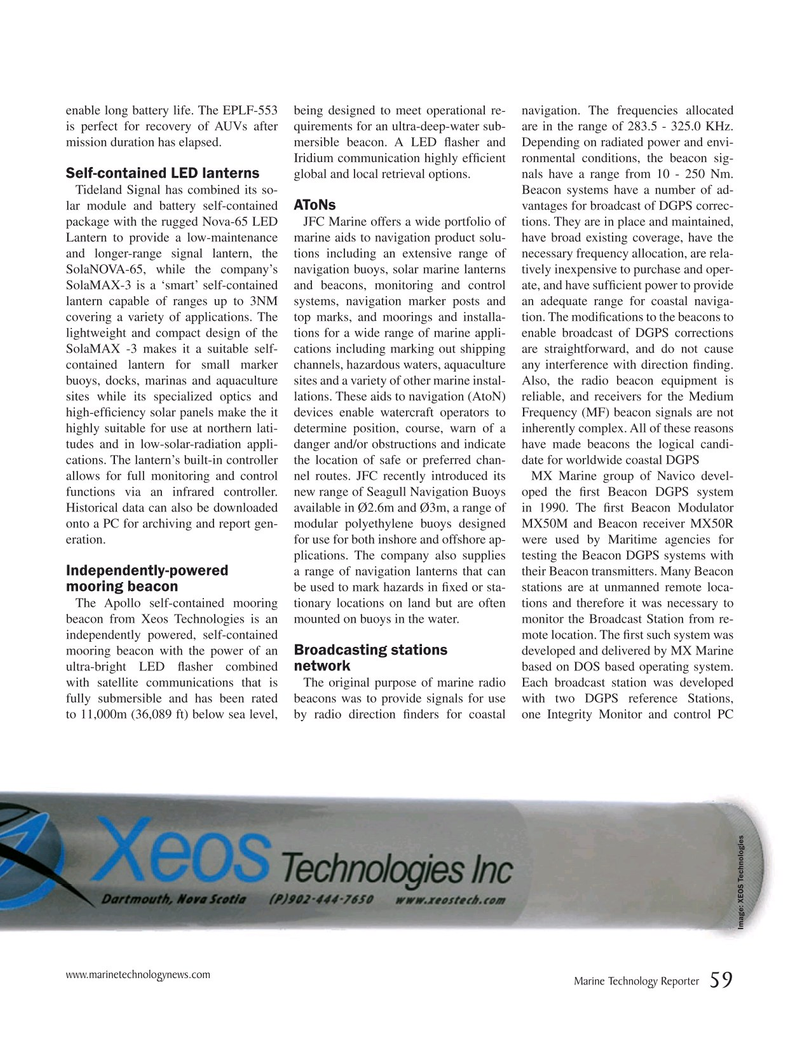
Page 59: of Marine Technology Magazine (May 2019)
Underwater Defense Technology
Read this page in Pdf, Flash or Html5 edition of May 2019 Marine Technology Magazine
enable long battery life. The EPLF-553 being designed to meet operational re- navigation. The frequencies allocated is perfect for recovery of AUVs after quirements for an ultra-deep-water sub- are in the range of 283.5 - 325.0 KHz. mission duration has elapsed. mersible beacon. A LED ? asher and Depending on radiated power and envi-
Iridium communication highly ef? cient ronmental conditions, the beacon sig-
Self-contained LED lanterns global and local retrieval options. nals have a range from 10 - 250 Nm.
Tideland Signal has combined its so- Beacon systems have a number of ad- lar module and battery self-contained vantages for broadcast of DGPS correc-AToNs package with the rugged Nova-65 LED JFC Marine offers a wide portfolio of tions. They are in place and maintained,
Lantern to provide a low-maintenance marine aids to navigation product solu- have broad existing coverage, have the and longer-range signal lantern, the tions including an extensive range of necessary frequency allocation, are rela-
SolaNOVA-65, while the company’s navigation buoys, solar marine lanterns tively inexpensive to purchase and oper-
SolaMAX-3 is a ‘smart’ self-contained and beacons, monitoring and control ate, and have suf? cient power to provide lantern capable of ranges up to 3NM systems, navigation marker posts and an adequate range for coastal naviga- covering a variety of applications. The top marks, and moorings and installa- tion. The modi? cations to the beacons to lightweight and compact design of the tions for a wide range of marine appli- enable broadcast of DGPS corrections
SolaMAX -3 makes it a suitable self- cations including marking out shipping are straightforward, and do not cause contained lantern for small marker channels, hazardous waters, aquaculture any interference with direction ? nding. buoys, docks, marinas and aquaculture sites and a variety of other marine instal- Also, the radio beacon equipment is sites while its specialized optics and lations. These aids to navigation (AtoN) reliable, and receivers for the Medium high-ef? ciency solar panels make the it devices enable watercraft operators to Frequency (MF) beacon signals are not highly suitable for use at northern lati- determine position, course, warn of a inherently complex. All of these reasons tudes and in low-solar-radiation appli- danger and/or obstructions and indicate have made beacons the logical candi- cations. The lantern’s built-in controller the location of safe or preferred chan- date for worldwide coastal DGPS allows for full monitoring and control nel routes. JFC recently introduced its MX Marine group of Navico devel- functions via an infrared controller. new range of Seagull Navigation Buoys oped the ? rst Beacon DGPS system
Historical data can also be downloaded available in Ø2.6m and Ø3m, a range of in 1990. The ? rst Beacon Modulator onto a PC for archiving and report gen- modular polyethylene buoys designed MX50M and Beacon receiver MX50R eration. for use for both inshore and offshore ap- were used by Maritime agencies for plications. The company also supplies testing the Beacon DGPS systems with
Independently-powered a range of navigation lanterns that can their Beacon transmitters. Many Beacon mooring beacon be used to mark hazards in ? xed or sta- stations are at unmanned remote loca-
The Apollo self-contained mooring tionary locations on land but are often tions and therefore it was necessary to beacon from Xeos Technologies is an mounted on buoys in the water. monitor the Broadcast Station from re- independently powered, self-contained mote location. The ? rst such system was mooring beacon with the power of an developed and delivered by MX Marine Broadcasting stations ultra-bright LED ? asher combined based on DOS based operating system. network with satellite communications that is The original purpose of marine radio Each broadcast station was developed fully submersible and has been rated beacons was to provide signals for use with two DGPS reference Stations, to 11,000m (36,089 ft) below sea level, by radio direction ? nders for coastal one Integrity Monitor and control PC
Image: XEOS Technologies www.marinetechnologynews.com
Marine Technology Reporter 59
MTR #4 (50-63).indd 59 4/26/2019 10:04:45 AM

 58
58

 60
60
